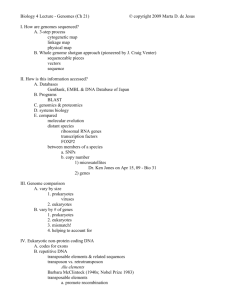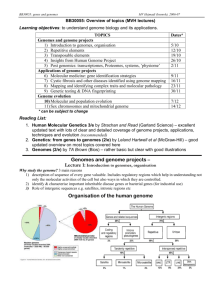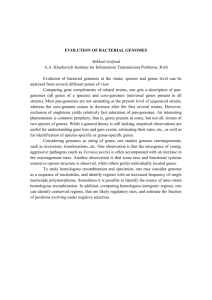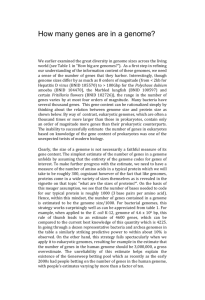What are genomes and how are they studied
advertisement
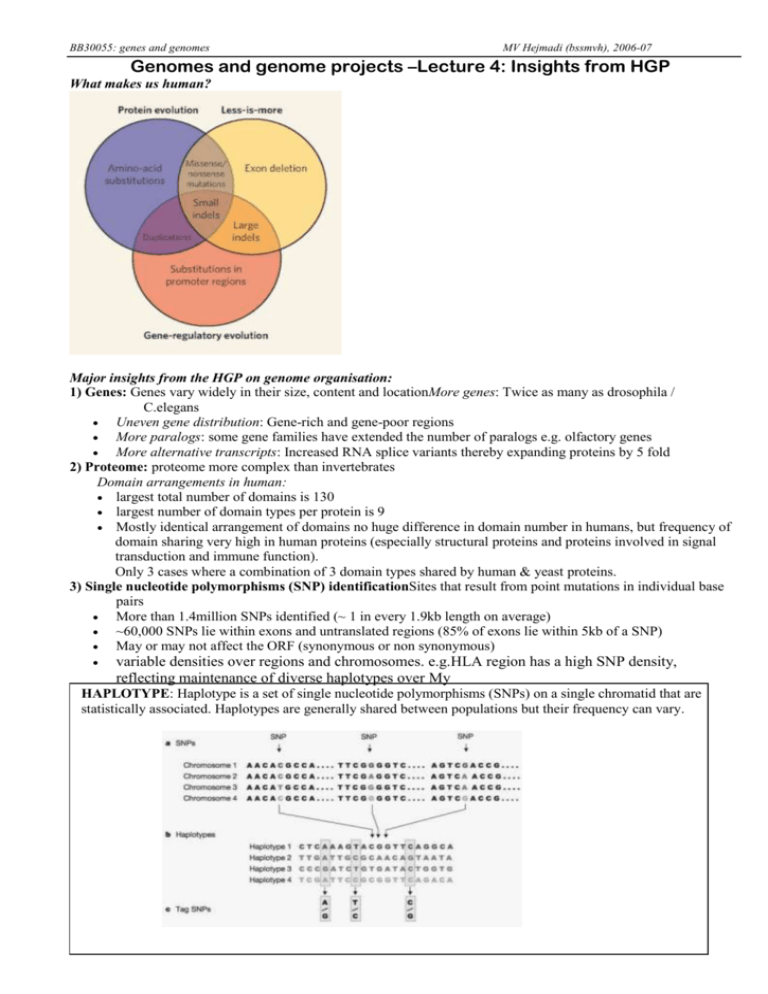
BB30055: genes and genomes MV Hejmadi (bssmvh), 2006-07 Genomes and genome projects –Lecture 4: Insights from HGP What makes us human? Major insights from the HGP on genome organisation: 1) Genes: Genes vary widely in their size, content and locationMore genes: Twice as many as drosophila / C.elegans Uneven gene distribution: Gene-rich and gene-poor regions More paralogs: some gene families have extended the number of paralogs e.g. olfactory genes More alternative transcripts: Increased RNA splice variants thereby expanding proteins by 5 fold 2) Proteome: proteome more complex than invertebrates Domain arrangements in human: largest total number of domains is 130 largest number of domain types per protein is 9 Mostly identical arrangement of domains no huge difference in domain number in humans, but frequency of domain sharing very high in human proteins (especially structural proteins and proteins involved in signal transduction and immune function). Only 3 cases where a combination of 3 domain types shared by human & yeast proteins. 3) Single nucleotide polymorphisms (SNP) identificationSites that result from point mutations in individual base pairs More than 1.4million SNPs identified (~ 1 in every 1.9kb length on average) ~60,000 SNPs lie within exons and untranslated regions (85% of exons lie within 5kb of a SNP) May or may not affect the ORF (synonymous or non synonymous) variable densities over regions and chromosomes. e.g.HLA region has a high SNP density, reflecting maintenance of diverse haplotypes over My HAPLOTYPE: Haplotype is a set of single nucleotide polymorphisms (SNPs) on a single chromatid that are statistically associated. Haplotypes are generally shared between populations but their frequency can vary. BB30055: genes and genomes MV Hejmadi (bssmvh), 2006-07 4) Distribution of GC content Genome wide average of 41%. Huge regional variations exist E.g.distal 48Mb of chromosome 1p-47% but chromosome 13 has only 36%. Confirms cytogenetic staining with G-bands (Giemsa); dark G-bands – low GC content (37%) light G-bands – high GC content (45%) 5) CpG islands (~28,890 in number) Greatly under-represented in human genome •CpG islands show no methylation •Variable density e.g. Y – 2.9/Mb but 16,17 & 22 have 19-22/Mb (average is 10.5/Mb) 6) Recombination rates •Recombination rate increases with decreasing chromosome arm length •Recombination rate suppressed near the centromeres and increases towards the distal 20-35Mb 7) Repeat content a) Age distribution Most interspersed repeats predate eutherian radiation LINEs and SINE have extremely long lives 2 major peaks of transposon activity No DNA transposition in the past 50MYr LTR retroposons teetering on the brink of extinction overall decline in IR activity in hominid lineage in past 35-40MYr compared to mouse genome b) Comparison with other genomes: Compared to fruitfly, C.elegans and plant genomes, human genomes show higher density of transposable elements in euchromatic portion of genome Higher abundance of ancient transposons 60% of IR made up of LINE1 and Alu repeats whereas DNA transposons represent only 6% c) Variation in distribution of repeats: regions show either a high repeat density (e.g. chromosome Xp11 – a 525kb region shows 89% repeat density) or a low repeat density (e.g. HOX homeobox gene cluster (<2% repeats), indicative of regulatory elements which have low tolerance for insertions) d) Distribution by GC content: (High GC – gene rich ; High AT – gene poor): LINEs abundant in AT-rich regions but SINEs lower in AT-rich regions. Alu repeats in particular, retained in actively transcribed GC rich regions. E.g. chromosme 19 has 5% Alus compared to Y e) Y chromosome: Unusually young genome (high tolerance to gaining insertions). Mutation rate is 2.1X higher in male germline. Working draft published – Feb 2001 Finished sequence – April 2003 Annotation of genes going on (refer: IHGSC. Finishing the euchromatic sequence of the human genome. Nature 21 October 2004) References: Chapter 9: Human Molecular Genetics 3 by Strachan and Read AND/OR Chapter 10: Genetics from genes to genomes by Hartwell et al (2/e) pp 339-348 Nature (2001) 409: pp 879-891 Nature (1st Sept 2005) for Chimp genome Vol 437 pp50-51.



